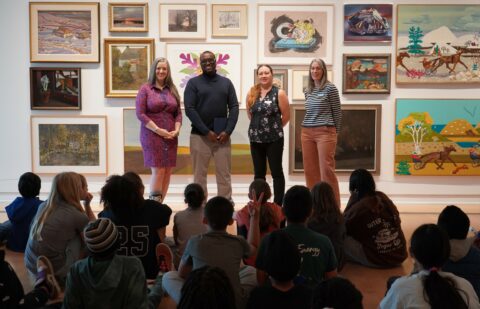Key Points
- Deaccessioning is the process by which a work of art or object is permanently removed from a gallery or museum’s collection.
- Artworks to be deaccessioned are presented and approved by the RMG’s Acquisitions and Collections Committee, then following the Committee’s recommendation, reviewed and approved by the RMG’s Board of Directors.
- The RMG is following the set of procedures for deaccessioning artworks outlined in our Collections Management Policy and several national, American, and international museum guidelines.
- Deaccessioned artworks are offered to other public galleries, sold through reputable art auction, returned to the original artist or, rarely, permanently destroyed.
During a 2020 Ask a Curator Instagram Live event, RMG Curator Sonya Jones was asked: “is Deaccessioning still a dirty word?” After chuckling at the question, Jones responded that she did not believe it was still a dirty word and that it was an important part of caring for collections in order to address storage issues and to refine the collections scope. The question was important; it is true that historically deaccessioning has been a contested issue in the museum and gallery world. The heart of the issue usually lies with what happens with any funds raised from the sales of collection items or if the work being removed is a beloved community favourite.
What is deaccessioning?
Deaccessioning is the process by which a work of art or object is permanently removed from a gallery or museum’s collection. Without this widely recognized and regulated collections management practice, institutions would be facing storage crises as well as having artworks that do not align with their collections mandate. The RMG’s permanent collection is rooted in its original focus on Painters Eleven and telling the continuing story of contemporary Canadian Art. When acquiring new artwork for the collection these areas are still a priority alongside an intention to collect work by equity deserving artists in order to reflect a more holistic, diverse, equitable, and reflective history of Canadian art.
How are artworks chosen for deaccessioning?
Following careful consideration and research by the curators, in March 2023 a list of artworks to be deaccessioned was presented and approved by the RMG’s Acquisitions and Collections Committee, then following the Committee’s recommendation, reviewed and approved by the RMG’s Board of Directors.
Like all galleries and museums, the RMG does not take deaccessioning lightly. Compiling the list of artworks was a lengthy and careful process. The RMG is following the set of procedures for deaccessioning artworks outlined in our Collections Management Policy, so that the process is handled in a sensitive and thoroughly documented manner according to sector guidelines. These procedures follow ethical standards and practices set by the current guidelines of the International Council of Museums (ICOM), the Canadian Museums Association (CMA), the Canadian Art Museums Directors Organization (CAMDO), the American Association of Museums (AAM), the Ontario Museums Association (OMA), and Galleries Ontario Galeries (GOG).
What criteria does an artwork need to meet to be deaccessioned?
When putting the list together, the RMG considered how each artwork fits within the collection, and whether its removal can open up the possibility for new and more priority acquisitions. If monies are realized from the deaccessioning of works of art, they may be used only for the purchase of other artworks or for collections care and management. Only artworks that meet the following strict Canadian Museum Association criteria can be considered for deaccessioned:
- Gallery’s inability to care for and maintain the artwork
- Lack of significance or relevance to the collection or terms of acquisitions
- Redundancy or duplication within the collection
- Work of poor quality or lesser importance
- Artwork determined to be false or fraudulent
- Artworks acquired through unethical means, and Repatriation
In the case of the works selected by the RMG, the criteria that these artworks meet are the gallery’s inability to care for or maintain the work, lack of significant or relevance to the collection, work of lesser importance and redundancy within the collection. The removal of these works will help the RMG better align the collection with our priorities for acquisition outlined in our Collections Management Policy, and will benefit both the scope of the collection and storage space.
What happens when artworks are deaccessioned?
How galleries and museums remove artworks from collections is also clearly outlined in the CMA’s deaccessioning guidelines. The RMG will prioritize keeping the artwork within the public domain, so will first offer to public galleries across Canada. We are committed to transparency, so we will make all effort to notify donors and artists of any transfer to another collection. Only if there’s no interest from public galleries will we put the artworks for public sale at a reputable art auction house such as Waddington’s Auctioneers & Appraisers. As mentioned earlier, any funds raised by the sale of artworks will only be used for purchasing new acquisitions and collections management. Artworks can also be returned to an artist so long as they were not the donor of the artwork. Permanent destruction is a last resort and is very rarely done. It is only considered if the artwork is damaged beyond reasonable repair so can’t be offered to another institution, made available for sale at auction, or the artist does not want it.
FAQs
Has the RMG deaccessioned anything before?
Yes, we have. Most recently in 2022 we deaccessioned the Pedlar People Lion, an object designed by Pedlar People Limited to decorate the entrance to Alexandra Park c. 1908. The decision was based on “Lack of significance or relevance to the collection or terms of acquisitions” as the Pedlar People Lion is more of a historical object than an artwork. Since the Pedlar Lion is an important object to Oshawa’s history, the RMG gifted it directly to the Oshawa Museum. This object is better suited to the collecting mandate of the Oshawa Museum and will have more opportunities for engagement and historical research.
Can the artwork be given back to their original donors?
No. When a person donates an item, they transfer all ownership over to The Robert McLaughlin Gallery. Donors may also have been issued a tax receipt when they donated items. If so, it would be against Canadian tax laws and cause for the Canada Revenue Agency to revoke charitable status.
Can the artwork be given back to the artist?
If the artist was not the donor of the artwork, then yes it can be returned to them. However, priority should be given to keeping it in a public collection to be enjoyed by all.
Who decides if an artwork is to be deaccessioned?
Many people are involved in the decision making process. First, the curator will recommend to the CEO artworks to be deaccessioned after extensive review and research. From there, a report and presentation is made to the Acquisition and Collections Committee, comprised of members of our Board of Directors. Following the Committee’s approval and recommendation, it then must be approved by a two-thirds majority vote of the Board of Directors.
If you have any questions or would like more information, please contact Sonya Jones, Interim Senior Curator or Lauren Gould, CEO at 905-576-3000.


